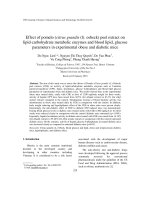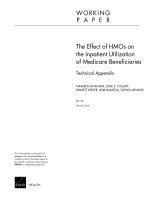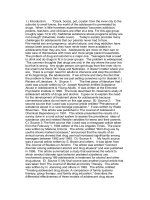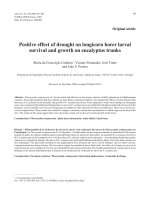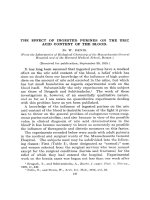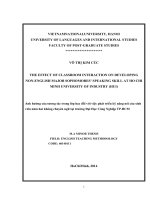Effect of vam on EX vitro hardening of doubled haploid line of marigold (Tagetes erecta L.) variety local orange
Bạn đang xem bản rút gọn của tài liệu. Xem và tải ngay bản đầy đủ của tài liệu tại đây (243.88 KB, 11 trang )
Int.J.Curr.Microbiol.App.Sci (2019) 8(1): 1393-1403
International Journal of Current Microbiology and Applied Sciences
ISSN: 2319-7706 Volume 8 Number 01 (2019)
Journal homepage:
Original Research Article
/>
Effect of VAM on ex vitro Hardening of Doubled Haploid Line of
Marigold (Tagetes erecta L.) Variety Local Orange
Uzma Mehraj1*, Sapna Panwar1, Kanwar Pal Singh1, Namita1 and Seema Sangwan2
1
Division of Floriculture and Landscaping, 2Division of Microbiology, ICAR- Indian
Agricultural Research Institute, New Delhi- 110012, India
*Corresponding author
ABSTRACT
Keywords
Tagetes erecta L.,
Doubled haploid
line, Ex vitro
hardening, VAM
Article Info
Accepted:
10 December 2018
Available Online:
10 January 2019
In this study, the effect of Vesicular Arbrbusular Mycorrhizae (VAM) on the ex vitro
hardening of marigold was investigated. A protocol was generated for ex vitro hardening
of in vitro raised plantlets using VAM consortia (Glomus intraradices, Glomus mosseae
and Scutellospora spp.) in different media mixtures, and their effect was observed on plant
survival and growth. Highest percent survival (94.00), maximum plant height (39.00 cm),
maximum plant spread (30.50 cm), maximum stem diameter (0.97 cm), maximum shoot
fresh weight (0.75 g), maximum root fresh weight (0.46 g), maximum leaf length (10.27
cm), maximum root length (28.50 cm) and maximum leaf width (6.82 cm) were observed
in treatment comprising of Soil + Vermicompost (3:1) + 20 g VAM consortia, Followed
by 92.00% plant survival, 36.75 cm plant height, 29.00 cm plant spread, 0.81 cm stem
diameter, 0.58 g shoot fresh weight, 0.45 g root fresh weight, 10.20 cm leaf length, 20.88
cm root length, and 6.76 cm leaf width in treatment comprising Soil + Vermicompost (1:1)
+ 20 g VAM consortia. While minimum percent survival (72.50%), lowest height (26.00
cm), minimum plant spread (9.50 cm), minimum stem diameter (0.49 cm), minimum shoot
fresh weight (0.27 g), minimum root fresh weight (0.14 g), minimum leaf length (8.06
cm), minimum root length (10.27 cm) and minimum leaf width (3.86 cm) were observed in
control media comprising of only soil. Followed by 85.00% survival, 29.25 cm plant
height, 17.75 cm plant spread, 0.51 cm stem diameter, 0.34 g shoot fresh weight, 0.28g
root fresh weight, 8.07 cm leaf length, 14.05 cm root length and 4.08 cm leaf width were
observed in media comprising of Soil + FYM (1:1) + 10 g VAM consortia. Highest
percent colonization (60.78) was showed in media comprising of Soil + Vermicompost
(3:1) + 20 g VAM consortia, followed by 57.65 % in media comprising of Soil +
Vermicompost (1:1) + 20 g VAM consortia. While lowest root colonization of 47.28%
was found in media comprising of Soil + FYM (1:1) + 10 g VAM consortia followed by
50.37% in media comprising of Soil+ FYM (3:1) +10 g VAM consortia. Control
treatment, without any VAM added, showed no root colonization. Hence, it was concluded
that the treatment with a mixture of Soil + Vermicompost (3:1) with 20 g VAM consortia
showed the best results in various aspects.
1393
Int.J.Curr.Microbiol.App.Sci (2019) 8(1): 1393-1403
Introduction
Marigold (Tagetes spp.) is one of the most
important flower crop known globally for its
ornamental and medicinal values. It is an
important member of Asteraceae family and
native to South and Central America
(Mexico). Genus Tagetes is reported of
comprising of approximately 55 species
(Godoy-Hernandez and Miranda-Ham, 2007),
out of which, Tagetes erecta L. (African
marigold) and Tagetes patula L. (French
marigold) are of commercial importance. In
India, marigold ranks first in area and
production of loose flower crops, being
cultivated in an area of 66.13 thousand
hectares with the production of 603.18
thousand metric tons (Anonymous, 2017) and
is grown almost throughout the country. It is
gaining popularity among flower growers. The
major drawback of in vivo propagation is lack
of sufficient plant material for large scale
multiplication and season bound nature of the
activity. Hence, to overcome such limitations,
in vitro mass multiplication is one of the best
options to obtain maximum population of
doubled haploids under short span of time.
The advantage of in vitro multiplication of
doubled haploids is that large number of
quality regenerants per explant can be
obtained and moreover, it is a year round
activity.
In vitro multiplication of doubled haploids has
been successfully done in crops like tall fescue
(Kasperbaeur and Eizenga, 1985); sugar beet
(Magdalena and Baranski, 2013) etc. The use
of doubled haploids developed through tissue
culture drastically reduces the time for precise
and efficient selection for desirable traits. Ex
vitro evaluation is essential to know the
stability and performance of doubled haploids
at field level. Moreover, the conditions to
which
micropropagated
plantlets
are
transferred from in vitro conditions to which
they
are
accustomed
to
distinct in
vivo conditions would be a kind of stress
(popularly referred to as transplantation
shock) to them.
Weak root system is one of the major
hindrances in the successful establishment of
the micropropagated plantlets in the field
conditions. In general, mycorrhizal fungi help
in the development of a stronger root system
(Ponton et al., 1990). Some plants exhibit
considerable dependence on mycorrhizae to
thrive in stressed situations (Barea et al.,
1993; Bethlenfalvay et al., 1987).
These potentials of symbiotic association
between
VAM
(Vesicular
Arbuscular
Mycorrhiza) fungal species and plant roots
strengthen the belief of its significance in
averting the transplantation shock brought
about
by
unfavorable
environmental
conditions (such as alteration in humidity and
nutritional conditions). VAM is a fungus that
penetrates the roots of a vascular plant in order
to help them to capture nutrients from the soil.
These fungi are scientifically well known for
their ability to uptake and transport mineral
nutrients from the soil directly into host plant
roots. The main beneficial effects reported are
the avoidance of transplanting shock, shorter
weaning phase (Salamanca et al., 1992),
higher plant growth variants. Micropropagated
plants usually have weak stomatal control.
Inoculating these plants with symbiotic fungi
leads to the production of lipids and abscissic
acid which are responsible for the control of
rate of transpiration. Moreover, AMF
(Arbuscular Mycorrhizal Fungi) colonization
of plants can improve growth by increasing
the uptake of phosphorus, zinc and other
minerals, reducing disease, increasing
transplanting uniformity by increasing
survival percentage, improving water relations
of the host plant and increasing drought
resistance.
1394
Int.J.Curr.Microbiol.App.Sci (2019) 8(1): 1393-1403
Materials and Methods
Per cent root colonization was calculated by
the following procedure
Plant material
The source of explant was the doubled haploid
line of African marigold variety Local Orange
developed through ovule culture. The plants of
the doubled haploid line were maintained
under net house conditions at the farm of the
Division of Floriculture and Landscaping,
ICAR- Indian Agricultural Research Institute,
New Delhi. The basal portion of leaf was used
as explants. After regenerating, the micro
shoots were given rooting and in vitro
hardening treatments and after maintaining the
raised plantlets under in vitro conditions, they
were taken out for ex vitro hardening
treatments.
Ex vitro hardening
The in vitro hardened plants after being taken
outside were hardened under ex vitro
conditions using VAM consortia. The VAM
consortia containing mixture of Glomus
intraradices,
Glomus
mosseae
and
Scutellospora spp. were used to observe their
effect on plant survival and growth. The
earthen pots of eight inches size were used for
growing the plants. The quantity of soil, FYM
and vermicompost were measured on the basis
of volume in 8 inch pots (v/v). Different
potting mixtures used with different VAM
consortia are given in table 1. The experiment
was carried out in completely randomized
design (CRD) with four replications. Each
replication consists of 20 plants.
Observations recorded
Survival of plantlets and association with
AMF
Per cent survival was recorded on the basis of
number of plants survived out of total number
of plants kept for hardening.
Clearing and staining root specimens For
Clearing and staining procedures root samples
were washed free of soil and then chopped in
to smaller (1-2 cm) segments.
Root specimens stored in capsules, were
washed under running tap water thoroughly.
The root samples were then placed in a beaker
containing 5-10% KOH solution for about 1530 minutes. The concentration of KOH and
time of incubation of roots varies as per the
age and tenderness of the roots.
KOH solution was poured off and the capsules
were rinsed well in a beaker using at least
three complete changes of tap water or until
no brown colour appears in the rinsed water.
The capsules were covered in the beaker with
alkaline H2O2 at room temperature for 10
minutes or until roots were bleached.
The capsules were rinsed in the beaker
thoroughly using at least three complete
changes of tap water to remove the H2O2.
The capsules were covered in the beaker with
1% HCl and soaked for 3-4 minutes and then
the solution was poured off. Rinsing was not
done after this because the specimens must be
acidified for proper staining.
The capsules were covered in the beaker with
staining solution (0.01% acid fuchsin in
lactoglycerol or 0.05% trypan blue in
lactophenol) and kept overnight for staining.
After removing from the capsules, the root
specimens were placed in glass petri plate
/multi-well plate for destaining. The
destaining solution (50% glycerol) is the
standard used in step 6, but without the stain.
1395
Int.J.Curr.Microbiol.App.Sci (2019) 8(1): 1393-1403
Sample storage and slide preparation stained
roots were observed in plain lactoglycerol on a
temporary slide (Figure 1).
Growth parameters
The various growth parameters were recorded
on the basis of average plant height of 20
plants that survived in each treatment after 15,
30 and 45 days. The various parameters
recorded are plant height (cm), plant spread
(cm), Stem diameter (cm), Shoot fresh weight
(g), Root fresh weight (g), Root length (cm),
Leaf length (cm), Leaf width (cm).
Data analysis
The experiments were laid out in completely
randomized design (CRD). Each treatment had
20 units and with four replications. Each
experiment was repeated at least twice and the
reported data are the means of two
experiments. Wherever applicable the data are
presented as mean ± standard error. All the
percentage data was subjected to angular
transformation before calculating ANOVA.
20 g VAM consortia, followed by 57.65 % in
treatment with Soil + Vermicompost (1:1) +
20 g VAM consortia and 54.95% in treatment
with Soil + FYM (3:1) + 20 g VAM consortia.
While the lowest root colonization of 47.28%
was found in treatment with Soil + FYM (1:1)
+ 10 g VAM consortia followed by 50.37% in
treatment with Soil+ FYM (3:1) +10 g VAM
consortia. Control treatment without any
VAM added showed no root colonization
(Table 2).
Plant height (cm)
It was observed that highest plant height
(39.00 cm) was observed in treatment with
Soil + Vermicompost (3:1) + 20 g VAM
consortia, followed by 36.75 cm plant height
in treatment with Soil + Vermicompost (1:1) +
20 g VAM consortia and 35.75 cm plant
height in treatment with Soil + FYM (3:1) +
20 g VAM consortia. While the lowest height
(26.00 cm) was found in treatment with only
soil (control) followed by 29.25 cm plant
height in treatment with Soil + FYM (1:1) +
10 g VAM consortia (Table 2).
Results and Discussion
Plant spread (cm)
Per cent survival (%)
From the experiment, it was concluded that
highest per cent survival (94.00) was found in
treatment with Soil + Vermicompost (3:1) +
20 g VAM consortia followed by 92.00%
survival in treatments with Soil +
Vermicompost (1:1) + 20 g VAM consortia
and treatment with Soil + FYM (3:1) + 20 g
VAM consortia, While minimum percent
survival was observed as (72.50%) in control
treatment (with soil only), followed by
85.00% survival in treatment with Soil + FYM
(1:1) + 10 g VAM consortia (Table 2).
It was concluded that maximum plant spread
(30.50 cm) was found in treatment with Soil +
Vermicompost (3:1) + 20 g VAM consortia,
followed by 29.00 cm plant spread in
treatment with Soil + Vermicompost (1:1) +
20 g VAM consortia and 23.25 cm plant
spread in treatment with Soil + FYM (3:1) +
20 g VAM consortia. While the minimum
plant spread (9.50 cm) was observed in
treatment with only soil (control) followed by
17.75 cm plant spread in treatment with Soil +
FYM (1:1) + 10 g VAM consortia (Table 2).
Per cent root colonization
Stem diameter (cm)
It was observed that highest per cent
colonization (60.78) was observed in
treatment with Soil + Vermicompost (3:1) +
It was observed that maximum stem diameter
(0.97 cm) was found in treatment with Soil +
Vermicompost (3:1) + 20 g VAM consortia,
1396
Int.J.Curr.Microbiol.App.Sci (2019) 8(1): 1393-1403
followed by 0.81 cm stem diameter in
treatment with Soil + Vermicompost (1:1) +
20 g VAM consortia and 0.77 stem diameter
in treatment with Soil + FYM (3:1) + 20 g
VAM consortia. While minimum stem
diameter (0.49 cm) was observed in treatment
with only soil (control) followed by 0.51 cm
stem diameter in treatment with Soil + FYM
(1:1) + 10 g VAM consortia. Data showed that
all the treatments were significantly different
over control, with soil only (Table 2).
(10.27 cm) was observed in treatment with
Soil + Vermicompost (3:1) + 20 g VAM
consortia, followed by 10.20 cm leaf length in
treatment with Soil + Vermicompost (1:1) +
20 g VAM consortia and treatment with Soil +
FYM (3:1) + 20 g VAM consortia. While
minimum leaf length (8.06 cm) was observed
in treatment with only soil (control) followed
by 8.07 cm leaf length in treatment with Soil +
FYM (1:1) + 10 g VAM consortia (Table 2).
Root length (cm)
Shoot fresh weight (g)
It was observed that maximum fresh weight of
shoot (0.75 g) was found in treatment with
Soil + Vermicompost (3:1) + 20 g VAM
consortia, followed by 0.58 g shoot fresh
weight in treatment with Soil + Vermicompost
(1:1) + 20 g VAM consortia and 0.57 cm
shoot fresh weight in treatment with Soil +
FYM (3:1) + 20 g VAM consortia.. While the
minimum shoot fresh weight (0.27 g) was
found as in treatment with only soil (control)
followed by 0.34 g shoot fresh weight in
treatment with Soil + FYM (1:1) + 10 g VAM
consortia (Table 2).
Root fresh weight (g)
It was observed that maximum root fresh
weight (0.46 g) was observed in treatment
with Soil + Vermicompost (3:1) + 20 g VAM
consortia, followed by 0.45 g root fresh
weight in treatment with Soil + Vermicompost
(1:1) + 20 g VAM consortia and 0.42 g root
fresh weight in treatment with Soil + FYM
(3:1) + 20 g VAM consortia. While minimum
root fresh weight (0.14 g) was found as in
treatment with only soil (control) followed by
0.28g root fresh weight in treatment with Soil
+ FYM (1:1) + 10 g VAM consortia
(Table 2).
Leaf length (cm)
It was observed that maximum leaf length
It was observed that maximum root length
(28.50 cm) was observed in treatment with
Soil + Vermicompost (3:1) + 20 g VAM
consortia, followed by 20.88 cm root length in
treatment with Soil + Vermicompost (1:1) +
20 g VAM consortia and 15.47 cm root length
in treatment with Soil + FYM (3:1) + 20 g
VAM consortia. While minimum root length
(10.27 cm) was observed in treatment with
only soil (control) followed by 14.05 cm root
length in treatment with Soil + FYM (1:1) +
10 g VAM consortia (Table 2).
Leaf width (cm)
It was observed that maximum leaf width
(6.82 cm) was found in treatment with Soil +
Vermicompost (3:1) + 20 g VAM consortia,
followed by 6.76 cm leaf width in treatment
with Soil + Vermicompost (1:1) + 20 g VAM
consortia and 6.43 cm leaf width in treatment
with Soil + FYM (3:1) + 20 g VAM consortia.
While minimum leaf width (3.86 cm) was
observed in treatment with only soil (control)
followed by 4.08 cm leaf width in treatment
with Soil + FYM (1:1) + 10 g VAM consortia
(Table 2). Micropropagation has been
extensively used for the rapid multiplication of
many plant species. However, its wider use is
restricted often by the high percentage of plant
loss when transferred to ex vitro conditions.
This is due to the fact that regenerant has to
adjust to varied abnormalities in ex vitro
1397
Int.J.Curr.Microbiol.App.Sci (2019) 8(1): 1393-1403
environments viz., high irradiance level, low
humidity, limiting water due to low hydraulic
conductivity of roots and root system
connections. Acclimatization of regenerates
will overcome this problem with gradual
lowering in air humidity (Bolar et al., 1998;
Lavanya et al., 2009).
The ultimate success of in vitro propagation
lies in the successful establishment of plants in
the soil (Saxena and Dhawan, 1999). To
acclimatize the micropropagated plants,
different workers have employed different
approaches towards successful establishment.
VAM is reported to increase the surface area
for nutrient absorption and hence, helps in
acclimatization; hence, present study was
aimed to develop an efficient acclimatization
technique using VAM for in vitro raised
plants.
The role of arbuscular mycorrhizal fungi
(AMF) in acclimatization has been exploited
with success.
Arbuscular-mycorrhizal fungi (AMF) have
been
successfully
used
to
improve
acclimatization, survival and growth of many
micropropagated fruit species (Lovato et al.,
1996) such as pistachios (Schubert and
Martinelli, 1988), pineapple (Guillemin et al.,
1992), apple (Branzanti et al., 1992; Sbrana et
al., 1994), pear and peach (Rapparini et al.,
1994), and Prunus rootstocks (Estaun et al.,
1994; Estaun et al., 1999).
In the present study, different hardening media
with different concentrations of VAM were
tested of which treatment with Soil +
Vermicompost (3:1) + 20 g VAM consortia
was found best.
Other workers also observed the similar
results as Arbuscular mycorrhizal fungi
(AMF) form symbiotic association with plant
roots and are involved in plant nutrient uptake,
growth and tolerance to environmental
stresses (Fitter and Moyersoen, 1996; Smith
and Read, 1997). The studies conducted by
Chitra (2014) on sesame and sorghum plants
showed a significant improvement in plant
growth due to vermicompost amendments.
The length and leaf surface area increased
considerably in the vermicompost treated
plants.
The growth response of these plants was
superior which in turn enhanced soil nutrients
and microbial population. The study also
established that the association of VAM fungi
with sesame and sorghum enhanced the
growth when compared with control.
Mehraban et al., (2009) showed significant
differences between cultivars of sorghum and
using mycorrhiza on plant height, number of
seed in spike, biomass, and root colonization.
Gupta et al., (2002) concluded that the VAM
inoculation could significantly increase the
root colonization, growth, essential oil yield
and nutrient acquisition of mint for obtaining
economic production under field conditions.
Experiments conducted by Azkon-Aguilar et
al., (1992) on avocado, showed that survival
of plantlets was highest in a soil - sand
substratum and was increased by inoculation
with Glomus sp. in a peat - perlite mix. They
also observed that Mycorrhizal infection by
Glomus sp during the acclimatization process
improved development of micropropagated
avocado plants.
Their experiments also revealed that
inoculation with other AM fungi showed that
Glomus deserticola, and to a lesser extent
Glomus mosseae, improved plant development
in the soil - sand mix. Hence, they concluded
that Mycorrhiza formation appears to play a
key role in favouring ex vitro development of
micropropagated plants of avocado.
1398
Int.J.Curr.Microbiol.App.Sci (2019) 8(1): 1393-1403
Table.1 Effect of VAM inoculation on ex vitro establishment and morphological parameters of in vitro raised plantlets of doubled
haploid line of African marigold variety Local Orange
Treatment (s)
Percent
survival(%)
72.50
(58.37)*±1.44
85.00
T1 -Soil + FYM (1:1) + 10
(67.33)±2.04
g VAM consortia
91.87
T2- Soil + FYM (1:1) + 20
(73.46) ±0.83
g VAM consortia
90.87
T3 - Soil + FYM (3:1) +
(72.41)±0.55
10 g VAM consortia
92.00
T4 - Soil + FYM (3:1) +
(73.62)±0.91
20 g VAM consortia
91.50
T5 - Soil+ Vermicompost
(73.10)±0.96
(1:1) +10g VAM
consortia
92.00
T6 - Soil + Vermicompost
(73.62)±0.91
(1:1) +20 g VAM
consortia
91.75
T7 - Soil + Vermicompost
(73.31)±0.63
(3:1) + 10g VAM
consortia
94.00
T8 - Soil + Vermicompost
(76.02)±1.35
(3:1) + 20g VAM
consortia
1.21
± SE(m)
3.54
C.D. (P0.05)
T0- Soil only(control)
Plant
height (cm)
Plant
spread(cm)
26.00± 1.08
9.50± 1.85
Stem
diameter
(cm)
0.49 ±0.01
29.25± 3.68
17.75± 2.56
0.51±0.01
0.34± 0.02 0.28 ±0.03
33.25± 1.31
20.25± 3.42
0.74± 0.02
0.53± 0.02
29.5 ± 0.29
18.25± 1.25
0.64 ±0.02
35.75± 4.62
23.25±2.69
34.75± 2.46
36.75± 2.29
30. 75±0.48
Root length
(cm)
Leaf width
(cm)
10.27± 0.11
3.86 ±0.05
8.07± 0.09
14.05± 0.06
4.08± 0.01
0.34 ±0.02
10.18± 0.07
15.21± 0.07
6.30± 0.04
0.36± 0.02
0.24 ±0.02
8.15 ±0.058
14.57± 0.19
4.44± 0.03
0.77± 0.03
0.57± 0.03
0.42 ±0.01
10.20 ±0.03
15.47± 0.05
6.43± 0.02
18.75 1.11
0.65± 0.02
0.36± 0.02
0.30± 0.02
9.41 ±0.20
15.19± 1.10
5.30± 0.01
29.00± 3.03
0.81± 0.02
0.58 ±0.02
0.45 ±0.01
10.20 ±0.03
20.88 ±0.10
6.76± 0.06
0.72± 0.01
0.40± 0.02
0.31 ±0.01
9.46± 0.03
15.20± 0.11
5.48±0.07
19.25±0.48
Shoot fresh
weight (g)
0.27± 0.03
Root
Leaf length
fresh
(cm)
weight (g)
0.14 ±0.03 8.06± 0.02
39.00± 5.28
30.50± 0.29
0.97 ±0.02
0.75± 0.02
0.46 ±0.04
10.27 ±0.11
28.50± 0.28
6.82± 0.31
2.93
N/A
2.14
6.24
0.02
0.05
0.02
0.07
0.02
0.07
0.09
0.26
0.14
0.40
0.04
0.12
*Values in parenthesis are angular values
1399
Int.J.Curr.Microbiol.App.Sci (2019) 8(1): 1393-1403
Table.2 Effect of VAM inoculation on root colonisation (percentage) in roots of in vitro raised
plantlets of doubled haploid line of African marigold variety Local Orange
Treatment (s)
Roots Colonisation (%) by
AMF
T0– control, soil only
T1 -- Soil + FYM (1:1) + 10 g VAM consortia
T2- Soil + FYM (1:1) + 20 g VAM consortia
T3 - Soil + FYM (3:1) + 10 g VAM consortia
T4 - Soil + FYM (3:1) + 20 g VAM consortia
T5 - Soil+ Vermicompost (1:1) +10 g VAM consortia
T6 - Soil + Vermicompost (1:1) +20 g VAM consortia
T7 - Soil + Vermicompost (3:1) + 10 g VAM consortia
T8 - Soil + Vermicompost (3:1) + 20 g VAM consortia
± SE(m)
C.D. (P0.05)
0.00
(0.00)±0.00
47.28
(43.43)±0.82
54.90
(47.79)±0.93
50.37
(45.20)±0.79
54.95
(47.82)±0.60
51.33
(45.74)±1.24
57.65
(49.38)±0.33
54.62
(47.63)±0.32
60.78
(51.21)±1.09
0.78
2.33
Fig.1 Root infection by VAM species (Glomus intraradices, Glomus mosseae and
Scutellospora sp.)
Vesicular growth of AMF
Arbuscular growth of AMF
1400
Int.J.Curr.Microbiol.App.Sci (2019) 8(1): 1393-1403
Hyphae of AMF
The effect of arbuscular mycorrhizal fungi
(AMF) on micropropagated banana plantlets
was evaluated by Yano-Melo et al., (1999)
during the acclimatization period. They
inoculated the Plants with Acaulospora
scrobiculata, Glomus clarum or Glomus
etunicatum. After cultivation in a greenhouse
for 3 months, they measured the height, leaf
area, fresh weight and dry matter of root and
shoots, level of AMF colonization, nutrient
level, photosynthesis and transpiration rate,
water potential and stomatal conductance.
They found that the plantlets inoculated with
AMF had greater height, leaf area and fresh
weight of shoots and roots, as well as higher
rates of photosynthesis and transpiration than
controls. They concluded that the plants
inoculated with Glomus were superior in most
of the evaluated parameters. Further, Wang et
al., (1993) did their experiments on
micropropagated plantlets of Gerbera
jamesonii,
Nephrolepis
exaltata
and
Syngonium podophyllum, in which they were
inoculated with two vesicular-arbuscular
mycorrhizal
(VAM)
fungi,
Glomus
intraradices
Glomus
vesiculiferum
Gerderman. They observed that mortality of
Gerbera and Nephrolepis mycorrhizal
plantlets was reduced at week 8 compared to
the non-inoculated control. They also found
that mycorrhizal substrates had a long term
benefit of increasing leaf and root dry weight
of Gerbera and Nephrolepis and that
Mycorrhizal
Gerbera
plants
flowered
significantly faster than non-mycorrhizal
plants.
References
Anonymous. (2017). Indian Horticulture
Database. (Online) Available Online
at .
Azcón-Aguilara, C., Barcelób, A., Vidala, M.
T. and de la Viñab G. (1992). Further
studies
on
the
influence
of
mycorrhizae
on
growth
and
development of micropropagated
avocado plants. Agronomie. 12: 837840.
Barea, J. M., Azcón, R. and Azcón-Aguilar C.
(1993). Mycorrhiza and crops.
Advances on Plant Pathology. 9:167189.
Bethlenfalvay, G. J., Brown, M. S., Mihara,
K. L. and Stafford, A. E. (1987).
GlycineGlomus-Rhizobium
Symbiosis V, Effects of mycorrhiza
on nodule activity and transpiration in
soyabeans under drought stress. Plant
Physiology. 85: 115–119.
Bolar, J. P., Norelli, J. L., Aldwinckle, H. S.
and Hanke, V. (1998). An efficient
method for rooting and acclimation of
micropropagated apple cultivars.
HortScience. 37: 1251-1252.
Branzanti, B., Gianinazzi-Pearson, V. and
1401
Int.J.Curr.Microbiol.App.Sci (2019) 8(1): 1393-1403
Gianinazzi, S. (1992). Influence of
phosphate fertilization on the growth
and nutrient status of micropropagated
apple infected with endomycorrhizal
fungi during the weaning stage.
Agronomie. 12: 841-846.
Chitra,
K.
(2014).
Infectivity
and
effectiveness of VAM on sesame and
Sorghum plants. International Journal
of Current Microbiology and Applied
Sciences. 4: 1022-1027
Estaún, V., Calvet, C., Camprubí, A. and
Pinochet, J. (1999). Long-term effects
of nursery starter substrate and AM
inoculation of micropropagated peach
× almond hybrid rootstock GF 677.
Agronomie. 19: 483–489.
Estaun, V., Calvet, C. and Camprubi, A.
(1994). Arbuscular mycorrhizae and
growth
enhancement
of
micropropagated prunus rootstock in
different soilless potting mixes.
Agricultural Science in Finland. 3:
263–267.
Fitter, A. H. and Moyersoen, B.
(1996). Evolutionary trends in root–
microbe symbioses. Philosophical
Transactions of the Royal Society of
London Series B. 351: 1367–1375.
Godoy-Hernandez, G. and Miranda-Ham, M.
L. (2007). Marigold biotechnology:
Tissue
culture
and
genetic
transformation. Transgenic Plant
Journal. 1: 169-174.
Guillemin, J. P., Gianinazzi, S. and
Trouvelot, A. (1992). Screening of
arbuscular endomycorrhizal fungi for
establishment of micropropagated
pineapple plants. Agronomie. 12: 831836.
Gupta, M. L., Prasad, A., Ram, M. and
Kumar, S. (2002). Effect of the
vesicular-arbuscular
mycorrhizal
(VAM) fungus Glomus fasciculatum
on the essential oil yield related
characters and nutrient acquisition in
the crops of different cultivars of
menthol mint (Menthaarvensis) under
field
conditions.
Bioresource
Technology. 81(1): 77-9.
Kasperbauer, M. J. and Eizenga, G. C. (1985).
Tall Fescue doubled haploids via
tissue culture and plant regeneration.
Crop Science. 25: 1091-1095.
Lavanya, M., Venkateshwarlu, B. and Devi,
B. P. (2009). Acclimatization of neem
micro shoots adaptable to semi-sterile
conditions.
Indian
Journal
of
Biotechnology. 8: 218-222
Lovato, P. E., Gianinazzi-Pearson,V.,
Trouvelot, A. and Gianinazzi, S.
(1996). The state of art of mycorrhizas
and micropropagation. Advances in
Horticultural science. 10: 46-52
Magdalena, Klimek-Chodacka, Rafal and
Baranski. (2013). Comparison of
haploid and doubled haploid sugar
beet clones in their ability to
micropropagate
and
regenerate.
Electronic Journal of Biotechnology.
16(2): 0717-3458
Mehraban, A., Vazan, S., Naroui, Rad, M. R.
and Ardakany, A. R. (2009). Effect of
vesicular-arbuscular
mycorrhiza
(VAM) on yield of sorghum cultivars.
Journal of Food, Agriculture &
Environment. 7: 461-463.
Ponton, F., Piche, Y., Parent, S. and Caron,
M. (1990). The use of Vesicular
arbuscular mycorrhizae in boston fern
production: I. Effect ofpeat-based
mixes. HortScience. 25: 183–189.
Rapparini, F., Baraldi, R., Bertazza, B.,
Branzanti, B. and Predieri, S. (1994).
Vesicular arbuscular mycorrhizal
inoculation of micropropagated fruit
tree. Journal of Horticultural Science.
69: 1101-1109.
Salamanca, C. P., Harrea, M. A. and Barea, J.
M. (1992). Mycorrhizal inoculation of
micropropagated woody legumes used
in revegetation programmes for
1402
Int.J.Curr.Microbiol.App.Sci (2019) 8(1): 1393-1403
desertified Mediterranean ecosystems.
Agronomie. 12: 869-87
Saxena, S. and Dhawan, B. (1999).
Regeneration
and
large-scale
propagation
of
bamboo
(Dendrocalamus
strictus
Nees)
through somatic embryogenesis. Plant
Cell Reports. 18: 438-443.
Sbrana, C., Giovannetti, M. and Vitagliano,
C. (1994). The effect of mycorrhizal
infection on survival and growth
renewal of micropropagated fruit
rootstocks. Mycorrhiza. 5:153-156.
Schubert, A. and Martinelli, A. (1988). Effect
of vesicular-arbuscular mycorrhizae
on growth of in vitro propagated
pistacia
integerrima.
Acta
Horticulture. 227: 441-443
Smith, S. E. and Read, D. J. (1997).
Mycorrhizal symbiosis. Cambridge,
UK: Academic Press.
Wang, H., Parent, S., Gosselin, A. and
Desjardins, Y. (1993). Vesiculararbuscular Mycorrhizal Peat-based
Substrates
Enhance
Symbiosis
Establishment and Growth of Three
Micropropagated Species. Journal of
American Society for Horticultural.
Scince. 118: 896-901.
Yano-Melo, A. M., Leonor, M., Orivaldo José
Saggin Júnior, Lima-Filho, J. M. and
Melo, N. F. (1999). Effect of
arbuscular mycorrhizal fungi on the
acclimatization of micropropagated
banana plantlets. Mycorrhiza. 9: 119123.
How to cite this article:
Uzma Mehraj, Sapna Panwar, Kanwar Pal Singh, Namita and Seema Sangwan. 2019. Effect of
VAM on ex vitro Hardening of Doubled Haploid Line of Marigold (Tagetes erecta L.) Variety
Local Orange. Int.J.Curr.Microbiol.App.Sci. 8(01): 1393-1403.
doi: />
1403
